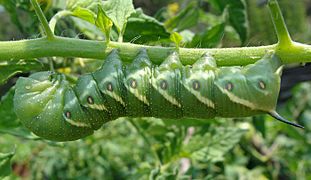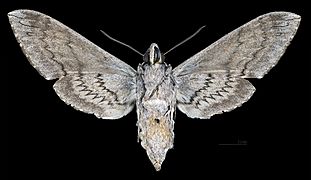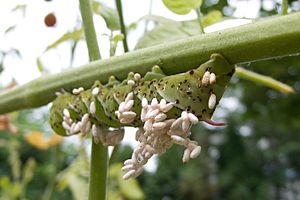Five-spotted hawkmoth facts for kids
Quick facts for kids Manduca quinquemaculata |
|
|---|---|
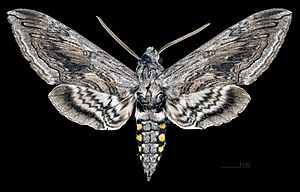 |
|
| Male - dorsal view | |
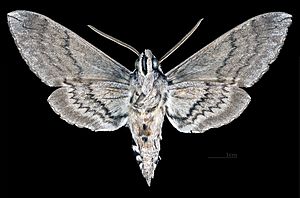 |
|
| Male - ventral view | |
| Scientific classification | |
| Synonyms | |
|
The Manduca quinquemaculata, also known as the five-spotted hawkmoth, is a brown and gray hawk moth. Its caterpillar is often called the tomato hornworm. This name comes from a dark spike on its back end. It also likes to eat tomato plants.
Tomato hornworms are a common garden pest. They are very similar to the tobacco hornworm. Both caterpillars look alike and eat plants from the Solanaceae family. This means you might find either one on tobacco or tomato leaves. The plant it's on does not tell you which species it is.
Contents
Where They Live
The five-spotted hawkmoth (M. quinquemaculata) lives all over North America and Australia. Its close relative, the tobacco hornworm, is more common in the southern United States. Tomato hornworms are found more often in the northern United States.
What They Eat
Larva Diet
Tomato hornworms are caterpillars. They eat many plants from the Solanaceae family. These include tomato, eggplant, pepper, tobacco, moonflowers, and potato. Female moths prefer to lay eggs on young leaves near the stem of these plants. Young caterpillars often stay there during the day. In the evening or early morning, they move to other leaves to feed.
Adult Diet
Adult moths drink nectar from flowers. They like plants with large, white, and fragrant flowers. Some of these plants are Datura meteloides, Oenothera caespitosa, and Mirabilis multiflora.
How Moths Help Plants
Hawkmoths, like M. quinquemaculata, are important pollinators for D. meteloides flowers. The moth has a long proboscis, which is like a straw. It is about 10 cm (4 inches) long. This helps it reach the nectar deep inside the flowers.
D. meteloides plants have special chemicals called alkaloids. These chemicals can make the moths act a bit strange. After drinking the nectar, the moths might fly erratically. They might also have trouble landing. Even so, they often come back for more nectar. Scientists think the "spiked" nectar might offer them something more than just food.
Mirabilis multiflora and Oenothera caespitosa also need hawkmoths for pollination. M. quinquemaculata moths seem to prefer Oenothera caespitosa first. They visit Mirabilis multiflora later.
Life Cycle
Egg Laying (Oviposition)
Female moths lay single eggs on host plant leaves in late spring. The eggs hatch into caterpillars in about one week. The female moth chooses where to lay her eggs carefully. She wants to protect her babies from predators. On the tobacco plant Nicotiana attenuata, young leaves near the stem are safer. Caterpillars that grow there also get bigger. So, females prefer to lay their eggs on these leaves. The eggs are large and can be pale green to off-white.
Larva Stage
M. quinquemaculata larvae are large green caterpillars. They can grow up to 10 cm (3.9 inches) long. They have a dark, pointed spike on their rear end. This is why they are called "hornworms."
It can be tricky to tell the tomato hornworm (M. quinquemaculata) from the tobacco hornworm (M. sexta). But you can look at their side markings. Tomato hornworms have eight V-shaped white marks with no borders. Their horns are dark blue or black. Tobacco hornworms have seven white diagonal lines with black borders. Their horns are red.
Caterpillars hatch in late spring or early summer. They grow through five stages, called instars. In warm places, two groups of caterpillars can grow in one summer. When a caterpillar is fully grown, it drops from its plant. Then it gets ready to pupate.
Pupa Stage
Caterpillars become pupae in early fall. This means they change into a pupa. Inside the pupa, they transform into a moth. After pupating, M. quinquemaculata spend the winter in the soil. They stay near the plants they ate. The adult moths come out the next summer.
Adult Moths
Adult moths are large. Their wingspan can be up to 13 centimetres (5.1 in). Their wings are brown and gray. The front wings are large and mottled. The back wings are smaller with light and dark zig-zag patterns. Their bodies are brown and white. They have a row of five yellow spots on each side. This gives them the name "five-spotted hawkmoth." You can tell M. quinquemaculata from M. sexta by the number of spots on their bodies.
Soon after the adults come out of the soil, they mate. Females then lay their eggs on host plants. This starts the life cycle all over again.
Tomato Hornworm and Tobacco Hornworm
M. quinquemaculata and M. sexta are both large hawkmoths. They belong to the same group, Manduca. Both the caterpillars and adults look similar. They also eat the same plants, like tobacco.
For a long time, scientists thought they were "sister species". This means they were thought to be each other's closest relatives. However, a recent study from 2013 looked at their family tree. It found that while they are closely related, they are not sister species. The study traced both species back to Central America. That is where they first became different species.
Controlling Pests
Because hornworm caterpillars eat crops like tomatoes and tobacco, people try to control them. Gardeners often pick the caterpillars off their plants by hand. Some gardeners plant marigolds near their tomato plants. Marigolds help keep the hornworms away. Many common birds also eat the larvae.
Natural Enemies
A tiny parasitoid wasp called Trichogramma attacks M. quinquemaculata eggs. The wasp larvae grow inside the moth egg. This stops the caterpillar from developing. Trichogramma is a natural enemy of the tomato hornworm. People also use it to control the hornworm population. This is called biological control.
Another parasitoid wasp, Cotesia congregata, also kills M. quinquemaculata. This wasp is from the family Braconidae. Adult female wasps lay their eggs inside the hornworm caterpillar's skin. When the wasp eggs hatch, the larvae eat the caterpillar's insides. Then they burrow out of the skin. They form cocoons on the caterpillar's back and sides. After the wasps come out of their cocoons, the weak caterpillar dies. These wasps are also a good way to control tomato hornworms.
Traps
Adult M. quinquemaculata moths fly mostly after dark. Early studies found that these moths are attracted to blacklight. Blacklights are used in some traps to catch them. These traps can be used for research. The moths can even be released after being caught. Some people have suggested using these traps to control the moth population. However, one study found that the traps did not reduce the population enough to make a big difference.
Images for kids


